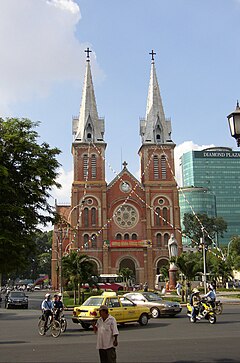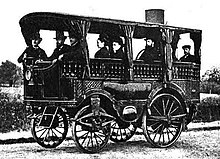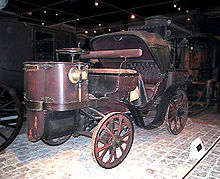

Amédée-Ernest Bollée (11 January 1844 – 20 January 1917) was a French bellfounder and inventor who specialized in steam cars. He is notable for developing the earliest known form of the independent suspension. After 1867 he was known as "Amédée père" to distinguish him from his similarly named son, Amédée-Ernest-Marie Bollée (1867–1926).
Biography
Bollée was the eldest son of Ernest-Sylvain Bollée, a bellfounder and inventor who moved to Le Mans in 1842. He became seriously ill in the 1860s and was obliged to delegate the day-to-day running of his businesses to his three sons. Amédée-Ernest was given charge of the bell foundry, while Ernest-Jules (1846–1922) supervised the hydraulic ram business and the youngest son, Auguste-Sylvain Bollée (1847–1906) assumed control of the Éolienne Bollée wind-turbine factory.
Steam vehicles
L'Obéissante

Amédée père manufactured his first steam vehicle L'Obéissante (The Obedient) in 1873 and made the first road trip between Paris and Le Mans in 18 hours. The L'Obéissante carried 12 passengers and had a cruising speed of 30 km/h (19 mph) and a top speed of 40 km/h (25 mph). It was driven by two V twin steam engines, one for each rear wheel. Front wheels were cushioned on the sliding pillar suspension which became the first ever independent front suspension. The original vehicle is preserved in the collection of the Conservatoire National des Arts et Métiers in Paris.
La Mancelle

In 1878 Amédée père designed La Mancelle, which is regarded as the first automobile to be put into series production, 50 being manufactured in all. It possessed such (for the period) advanced features as rear-wheel drive (via shaft to the differential and then via chain to the rear wheels) and independent suspension on all four wheels. The original vehicle is preserved in the collection of the Musée de l'Automobile de la Sarthe.
La Marie-Anne

The public demonstrations of L'Obeissante and La Mancelle had secured orders for the Bollée factory, and Amédée père accepted an order for a road train which was completed in 1879. Developing 100 hp (101 PS; 75 kW), La Marie-Anne had a three speed gearbox and was capable of towing 35 tonnes (34 long tons; 39 short tons) on a 6% slope.
La Nouvelle
Amédée père had derived from La Mancelle different vehicles that he delivered in a variety of styles of bodywork such as: limousine, coach, omnibus etc. The La Nouvelle was from this series and was completed in 1880. The rear of the vehicle was designed to receive the piston engine, this time rejected near the boiler in order to enlarge the passenger cabin.
La Rapide

La Rapide (The Rapid) was built in 1881 and was noted for achieving a speed of 62 km/h (39 mph). La Rapide grouped the boiler, the engine and the controls at the front of the vehicle, thus making it possible for it to be driven by a single operator.
See also
References
- Institut international d'informatique Léon Bollée Archived May 10, 2008, at the Wayback Machine in Ho Chi Minh City (Vietnam)
- According to le registre d'État-civil de la commune de Sainte-Croix, acte no 2 de 1844
- Simionescu, P. A.; Norton, Robert L. (2024). Okada, Masafumi (ed.). "On the History of Early Automobile Suspension Systems". Advances in Mechanism and Machine Science. Cham: Springer Nature Switzerland: 1012–1022. doi:10.1007/978-3-031-45709-8_99. ISBN 978-3-031-45709-8.
- "1873 "L'Obéissante" by Amédée Bollée". History of the Automobile: origin to 1900. Hergé. Archived from the original on 2020-07-16. Retrieved 2020-07-15.
- "1878 "La Mancelle" by Amédée Bollée". History of the Automobile: origin to 1900. Hergé. Archived from the original on 2020-07-16. Retrieved 2020-07-15.
- "1880 "La Nouvelle" by Amédée Bollée". History of the Automobile: origin to 1900. Hergé. Archived from the original on 2020-07-15. Retrieved 2020-07-15.
- "1881 "La Rapide" by Amédée Bollée". History of the Automobile: origin to 1900. Hergé. Archived from the original on 2020-07-15. Retrieved 2020-07-15.
External links
In French:
- La Obeissante 1873 Archived 2011-05-21 at the Wayback Machine
- La Mancelle 1878 Archived 2011-05-21 at the Wayback Machine
- La Marie-Anne 1879 Archived 2007-05-26 at the Wayback Machine
- La Nouvelle 1880 Archived 2010-03-29 at the Wayback Machine
- La Rapide 1881 Archived 2016-03-03 at the Wayback Machine